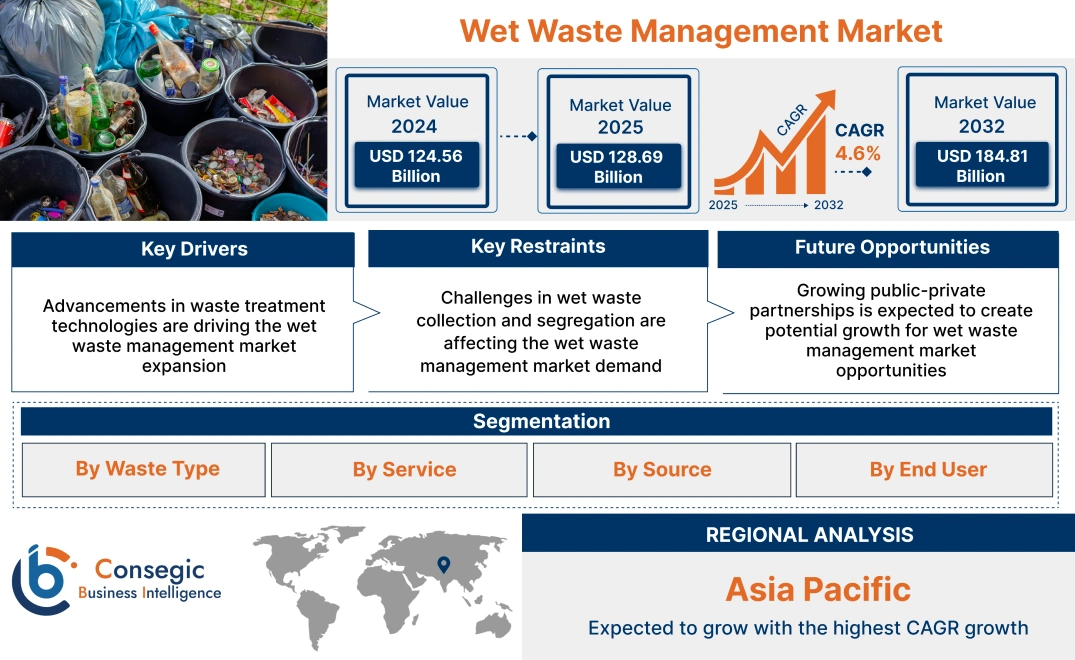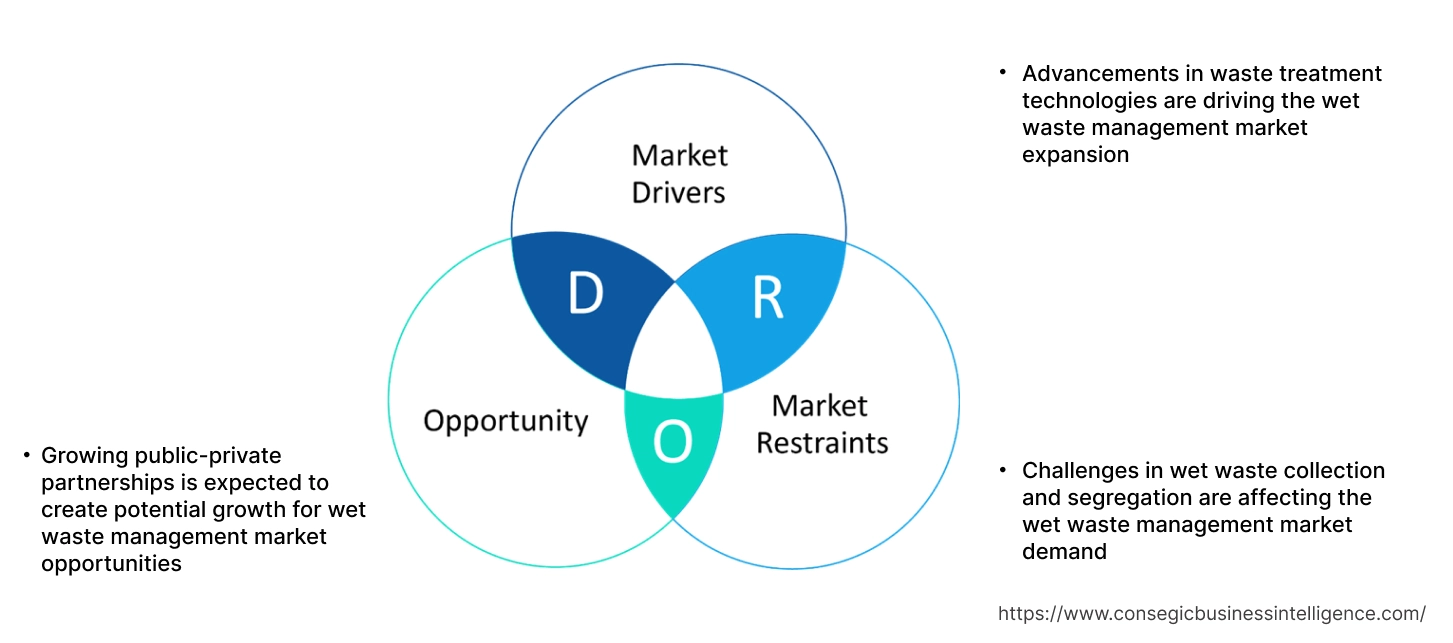- Summary
- Table Of Content
- Methodology
Wet Waste Management Market Size:
Wet Waste Management Market Size is estimated to reach over USD 184.81 Billion by 2032 from a value of USD 124.56 Billion in 2024 and is projected to grow by USD 128.69 Billion in 2025, growing at a CAGR of 4.6% from 2025 to 2032.
Wet Waste Management Market Scope & Overview:
Wet waste management involves managing biodegradable and non-biodegradable materials, such as scraps, food scraps, and yard waste, through anaerobic digestion and composting. It reduces the landfill burden that creates resources, such as compost and biogas. Additionally, wet waste management involves regulatory compliance, public awareness campaigns, and stakeholder engagement to promote waste reduction, recycling, and sustainable practices. With a focus on minimizing environmental pollution, conserving natural resources, and supporting circular economy principles, the industry plays a crucial role in fostering environmental sustainability and mitigating the adverse impacts of waste generation on ecosystems and public health.
Key Drivers:
Advancements in waste treatment technologies are driving the wet waste management market expansion
The technological advancements have enabled the integration of digitalization, automation, and data analytics into wet wastage management processes, enhancing operational efficiency, resource optimization, and environmental performance. Smart waste management systems equipped with sensors, IoT devices, and predictive analytics enable real-time monitoring of waste collection, transportation, and treatment activities, facilitating proactive decision-making and optimization of resource allocation. Moreover, advancements in remote sensing, imaging technologies, and machine learning algorithms offer opportunities for improved waste characterization, sorting, and quality control, enhancing the recovery of valuable materials from wet waste streams.
- For instance, in November 2023, Veoila deployed digital solutions, Hubgarde, in Barcelona, to enable the smart monitoring of the production and consumption of waste, energy, and water. The solutions help industries to improve waste recovery by enabling camera identification and better adaptation to logistical challenges.
Thus, according to the wet waste management market analysis, the growing advancements in waste treatment technologies are driving the wet waste management market size.
Key Restraints:
Challenges in wet waste collection and segregation are affecting the wet waste management market demand
Wet waste collection and segregation pose significant restraints due to the heterogeneous nature of waste streams, varying waste generation patterns, and limited public participation. Inadequate collection coverage, irregular collection schedules, and limited access to collection services hinder the efficient removal of wet waste from households, businesses, and public spaces, leading to accumulation, littering, and environmental pollution. Additionally, logistical restraints such as narrow streets, limited vehicle access, and traffic congestion further complicate wet waste collection efforts, delaying service delivery and increasing operational costs for waste management authorities and service providers.
Moreover, many individuals and households lack awareness of the importance of segregating wet waste from other waste streams and may lack the motivation or incentives to participate in segregation initiatives. Inadequate segregation infrastructure, such as separate bins or collection containers for wet waste, further worsens the challenge, making it difficult for residents to segregate waste effectively. Thus, the aforementioned factors would further impact the wet waste management market size.
Future Opportunities:
Growing public-private partnerships is expected to create potential growth for wet waste management market opportunities
Public-private partnerships (PPPs) are crucial in driving the adoption and implementation of innovative waste management solutions. These partnerships enable the pooling of resources, expertise, and technologies from both public and private sectors to develop and deploy smart waste management systems. Governments are increasingly collaborating with private companies to enhance waste collection, processing, and recycling efficiency through advanced technologies such as IoT sensors, data analytics, and automation. By leveraging these technologies, cities can improve waste management operations, reduce operational costs, and enhance sustainability.
Public-private partnerships facilitate large-scale investments in smart waste management infrastructure, which might be challenging for governments to finance independently. Private companies bring in capital, technological expertise, and innovative solutions, while public entities provide regulatory support, access to data, and integration with existing waste management systems. These collaborations result in the deployment of smart bins, automated waste collection vehicles, and real-time monitoring systems that optimize waste collection routes, reduce fuel consumption, and lower greenhouse gas emissions.
- For instance, in March 2025, Indore Municipal Corporation announced the PPP model, to set a first green waste processing plant. The facility will recycle branches and wood into wooden pellets, while providing a sustainable alternative to coal. The plant will be managed by Astronomical Industries Private Limited, which will deploy drying process, to reduce moisture content by 90% converting waste into sawdust.
Thus, based on the above wet waste management market analysis, the growing public-private partnerships are expected to drive the wet waste management market opportunities.
Wet Waste Management Market Segmental Analysis :
By Waste Type:
Based on waste type, the wet waste management market is segmented into biodegradable and non-biodegradable.
Trends in the waste type:
- Governments, municipalities, and private companies are investing in advanced technologies to improve waste collection, recycling, and disposal methods, aiming to reduce the environmental footprint of waste and promote circular economy practices. This trend is further fuelled by increasing public awareness of the negative effects of wet waste on the environment and public health.
- As urbanization continues to rise and the volume of waste generation increases globally, the demand for waste management solutions for efficient collection, sorting, recycling, and disposal of solid waste is expanding.
- Thus, the above factors are driving the wet waste management market demand.
The biodegradable segment accounted for the largest revenue in the year 2024.
- The waste-to-energy segment has gained traction, particularly in developed regions, as it allows waste to be converted into renewable energy through processes such as incineration and gasification, offering a dual benefit of waste reduction and energy production.
- Consumers are actively seeking products packaged in biodegradable or compostable materials to reduce their environmental footprint. As awareness of the environmental impact of single-use plastics continues to rise, brands are responding by offering eco-friendly packaging solutions, making biodegradable products a preferred choice for environmentally conscious consumers.
- For instance, in January 2025, IIT Madras established a center to develop zero waste bioplastics. The center will develop alternatives to traditional plastics, which will address the growing concerns about the effect of plastics and micro plastics on human health.
- Thus, based on the above analysis, these factors are further driving the wet waste management market growth.
The non-biodegradable segment is anticipated to register the fastest CAGR during the forecast period.
- As environmental concerns about plastic waste and its long-term impact on ecosystems grow, consumers are becoming increasingly aware of the need for sustainable alternatives. The widespread problem of plastic pollution, particularly in oceans and landfills, has spurred a shift in consumer behavior.
- Advancements in recycling and processing technologies are enhancing the sustainability and cost-effectiveness of bio-based biodegradable plastics. For example, improvements in composting and biodegradation processes are making it easier and cheaper to produce plastics that break down efficiently in natural environments. As these technologies continue to evolve, they will make it more feasible for companies to scale up production and offer biodegradable plastics at competitive prices.
- Thus, based on the above analysis, these factors are expected to drive the wet waste management market share during the forecast period.
By Service:
Based on service, the market is segmented into collection & transportation, disposal & landfill, processing, sorting, and storage.
Trends in the service:
- Governments worldwide are implementing stricter regulations to reduce landfill waste and promoting sustainable waste management practices. These regulations mandate source separation of wet waste and incentivize recycling and composting services.
- As municipalities face budget constraints, there is a growing adoption of outsourcing waste management services to private companies that can offer more efficient and cost-effective solutions. This has opened new revenue prospects for companies in waste management sector.
The collection and transportation segment accounted for the largest revenue share in the year 2024.
- Transportation services play a crucial role in the safe and compliant movement of wet waste from collection points to treatment facilities or disposal sites.
- This service involves the use of dedicated vehicles, tanks, and pipelines designed to transport liquid waste efficiently while adhering to stringent safety protocols and environmental regulations.
- Effective transportation logistics ensure timely delivery and minimize the risk of spills or leaks, thereby reducing potential environmental and public health hazards associated with improper waste handling.
- For instance, in August 2024, Bruhat Bengaluru Mahanagara Palike (BBMP) introduced leak-proof trucks, to handle waste and leaking garbage. The trucks are designed for zero leakage and eliminate the foul smell.
- Furthermore, regulations regarding emissions and waste transportation safety are prompting service providers to adopt eco-friendly transportation solutions, which include the use of alternative fuels and electric vehicles.
- Thus, based on the above analysis, these factors would further supplement the wet waste management market
The processing and recycling segment is anticipated to register the fastest CAGR during the forecast period.
- The segment involves the recovery and processing of waste into reusable materials, thereby, diverting waste from landfills and contributing to resource conservation. Technological advancements in recycling processes are enhancing the efficiency of material recovery, making recycling an attractive option for waste management companies.
- Smart processing technologies, including waste-to-energy systems, convert waste into usable energy, contributing to renewable energy goals and reducing reliance on landfills. By integrating these advanced solutions, cities can not only manage waste more effectively but also turn it into a resource, driving economic and environmental benefits.
- These developments in the processing and recycling segment are anticipated to further drive the wet waste management market trends during the forecast period.
By Source:
Based on source, the wet waste management market is segmented into industrial, residential, commercial, and others.
Trends in the source:
- With rapid urbanization and population growth, the volume of municipal and industrial waste generated globally has been steadily increasing, driving the demand for efficient waste management solutions.
- Industrial sectors such as manufacturing, chemicals, oil and gas, and automotive produce large quantities of waste, necessitating effective waste management strategies to minimize environmental harm and optimize the use of resources. As industries become more conscious of their sustainability goals, the demand for innovative waste management solutions is expected to increase.
The industrial segment accounted for the largest revenue share of 36.79% in the year 2024.
- Growing awareness of sustainability and resource recovery is becoming a major driver in the global industrial waste management market. As environmental concerns increase, both consumers and businesses are recognizing the need to minimize waste and maximize the reuse of materials. This awareness is pushing industries to adopt more sustainable practices, such as recycling, upcycling, and waste-to-energy solutions.
- In the treatment of industrial waste, technologies such as waste-to-energy (WTE) systems are gaining traction as a sustainable solution. These systems convert waste materials into electricity, heat, or fuel, reducing the reliance on landfills while producing renewable energy.
- The growing adoption of digital technologies is also improving waste management operations. IoT-enabled sensors and data analytics allow companies to monitor waste generation, track disposal processes, and optimize collection routes. This data-driven approach helps businesses reduce waste accumulation, streamline operations, and improve recycling rates.
- For instance, in November 2021, Waste Management Inc. announced that they have invested USD 200 million in recycling infrastructure, to bring company’s investment in upgraded facilities to over USD 700 million. With this investment, the company will enable to capture more recycled materials and enable the access to recycling for their customers.
- Thus, based on the above analysis, these factors are driving the wet waste management market growth.
The residential segment is anticipated to register the fastest CAGR during the forecast period.
- The increasing urban population density is resulting in higher volumes of residential waste, necessitating efficient management solutions.
- Various community-based initiatives, such as composting programs and waste segregation at source, are being implemented to manage residential wet waste effectively.
- The involvement of local municipalities in raising awareness about sustainable waste practices among residents, which is also a major factor driving growth in this segment.
- For instance, Saahas Zero Waste, a non-profit organization which manages waste management and resource management, is providing waste management solutions for residences in India. The organization has developed a coordination with all the stakeholders, such as property managers, Resident Welfare Associations, housekeeping teams, and maintenance staff, so that residents can transition towards effective waste management solutions.
- These factors are anticipated to further drive the wet waste management market trends during the forecast period.
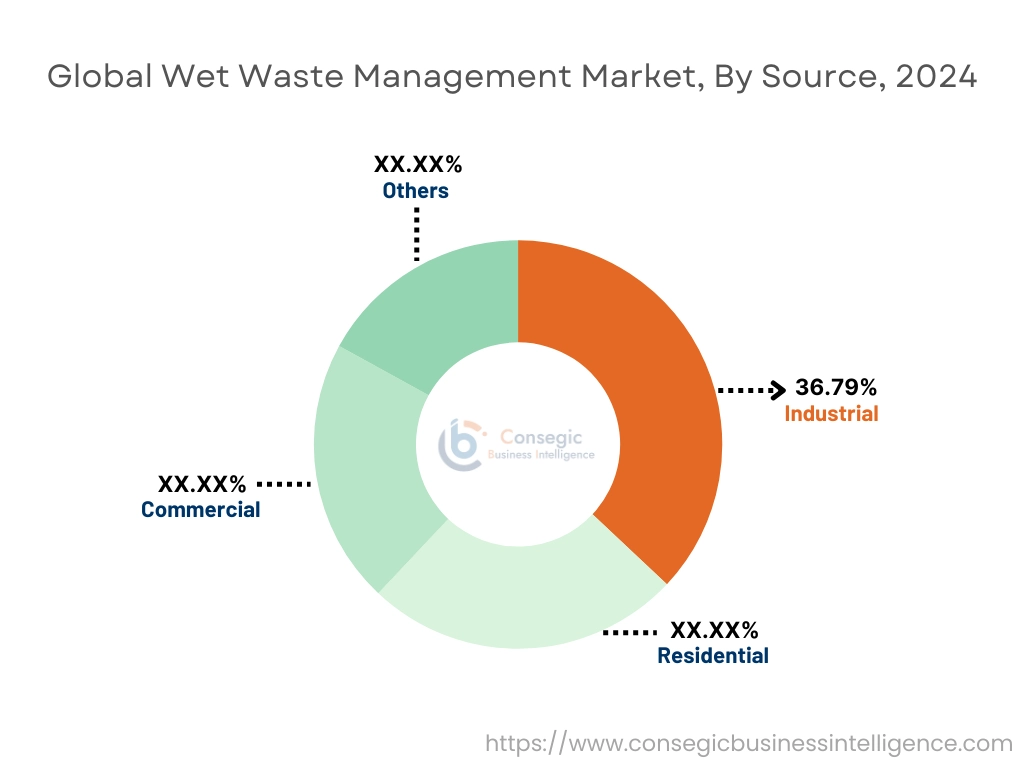
By End User:
Based on end user, the market is segmented into construction, facilities management, food & beverages, transportation, manufacturing, retail, hospitality and leisure, energy & utilities, and others.
Trends in the end user:
- The integration of recycling and waste-to-energy initiatives within smart waste management frameworks supports circular economy principles and reduces the reliance on landfills. As industries are prioritizing sustainable development, the need for smart waste management solutions is expected to grow.
- Initiatives such as waste audits and zero-waste programs are becoming common in several industries, driving demand for efficient waste management services.
The food and beverages segment accounted for the largest revenue share in the year 2024.
- The segment growth can be attributed to the increasing awareness of the environmental impact of food waste and stricter regulations on waste disposal.
- Businesses generating food waste, such as processing plants, distributors, and restaurants must report details on their waste's origin, volume, and disposal methods. This transparency allows for accurate cost analysis by businesses and informs regulatory efforts to reduce food waste by understanding its sources and scale.
- Countries worldwide are implementing policies to reduce landfill waste and promote recycling, encouraging the adoption of food waste disposal units as part of broader sustainability agendas.
- For instance, according to United Nations Environment Programme’s Food Waste Index Report (FWIR) 2022, approximately 1.05 billion tons of food was wasted in 2022. This issue highlights mere resource management, representing environmental failure.
- Thus, based on the above factors, these developments in the food and beverages segment are driving the global market trends.
The manufacturing segment is anticipated to register the fastest CAGR during the forecast period.
- The innovations in waste management and disposal technologies, such as waste-to energy conversion, recycling, and smart waste management systems, are transforming the manufacturing sector.
- Smart waste management technologies in the manufacturing sector help optimize waste sorting, recycling, and disposal while adhering to stringent environmental regulations.
- Sensors and tracking systems enable real-time monitoring of waste levels, ensuring that waste is disposed of or recycled appropriately and efficiently.
- The manufacturing sector also benefits from data analytics that can help identify waste reduction prospects and improve overall sustainability.
- These factors are anticipated to further drive the global market during the forecast period.
Regional Analysis:
The global market has been classified by region into North America, Europe, Asia-Pacific, Middle East & Africa, and Latin America.
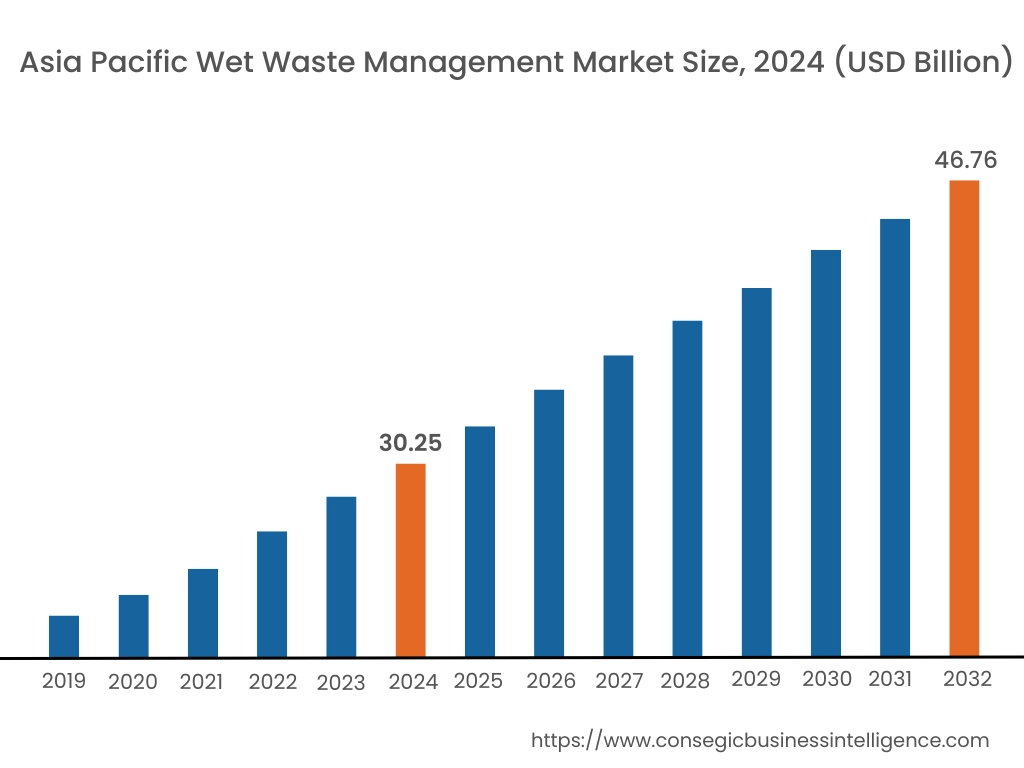
Asia Pacific wet waste management market expansion is estimated to reach over USD 46.76 billion by 2032 from a value of USD 30.25 billion in 2024 and is projected to grow by USD 31.36 billion in 2025. Out of this, the China market accounted for the maximum revenue split of 28.89%. The region's expanding urban centers generate significant volumes of wet waste, necessitating investments in waste collection, treatment, and disposal infrastructure to address environmental and public health concerns. Moreover, the region’s growing focus on environmental protection, resource conservation, and sustainable development drives demand for advanced wet waste management technologies and services. As governments and businesses in the region prioritize waste reduction, recycling, and circular economy initiatives, developments for market expansion and innovation in waste management are expected to grow. These factors would further drive the regional wet waste management market during the forecast period.
- For instance, in December 2024, Uttar Pradesh government announced the launch of integrated waste management city/learning center in Gorakhpur by September 2025. The initiative aims to make the city junk-free and boost environmental waste management through circular economy model. According to Gorakhpur Municipal Corporation, the project will process several types of waste, while producing Bio-CNG.
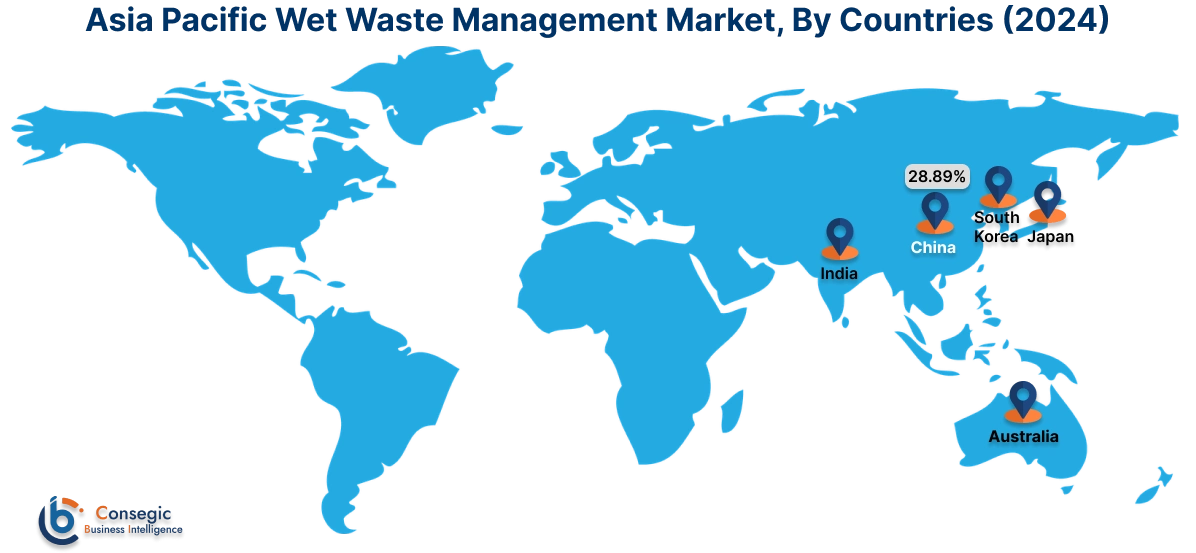
North America market is estimated to reach over USD 59.53 billion by 2032 from a value of USD 40.50 billion in 2024 and is projected to grow by USD 41.81 billion in 2025. North America holds a significant market share in the wet waste management sector, driven by stringent environmental regulations, advanced waste management infrastructure, and growing public awareness of sustainability issues. The region's robust economy and high levels of urbanization contribute to the generation of substantial volumes of wet waste, necessitating comprehensive waste management solutions to mitigate environmental impact and promote resource recovery. Additionally, North America's emphasis on recycling, composting, and waste-to-energy initiatives supports market growth and innovation in wet waste management technologies and services. These factors would further drive the regional market.
- For instance, in January 2025, Ontario local government announced the ban on sending organic waste to landfills or incinerators under the Environmental Protection Act. This initiative reflects the country’s commitment to address climate change and promote sustainable practices across several industries and municipalities.
Additionally, according to the analysis, the wet waste management industry in Europe is projected to witness significant development during the forecast period. Countries in Europe have implemented ambitious waste management targets and legislation, driving investment in waste collection, sorting, recycling, and treatment infrastructure. The region's emphasis on extended producer responsibility, landfill diversion, and organic waste management contributes to the development of innovative wet waste management solutions and promotes the regional growth.
Additionally, Governments across Latin America implemented stringent regulations and initiatives to address environmental challenges, spurring the need for advanced waste treatment and disposal solutions. Furthermore, increasing public awareness and corporate sustainability goals propelled investments in waste management infrastructure, contributing to the regional development. Further, Middle East & African countries continued to prioritize sustainable waste management practices. The region's proactive approach towards environmental conservation and waste reduction contributed to its significant market development, while attracting investments in innovative waste management technologies and infrastructure development.
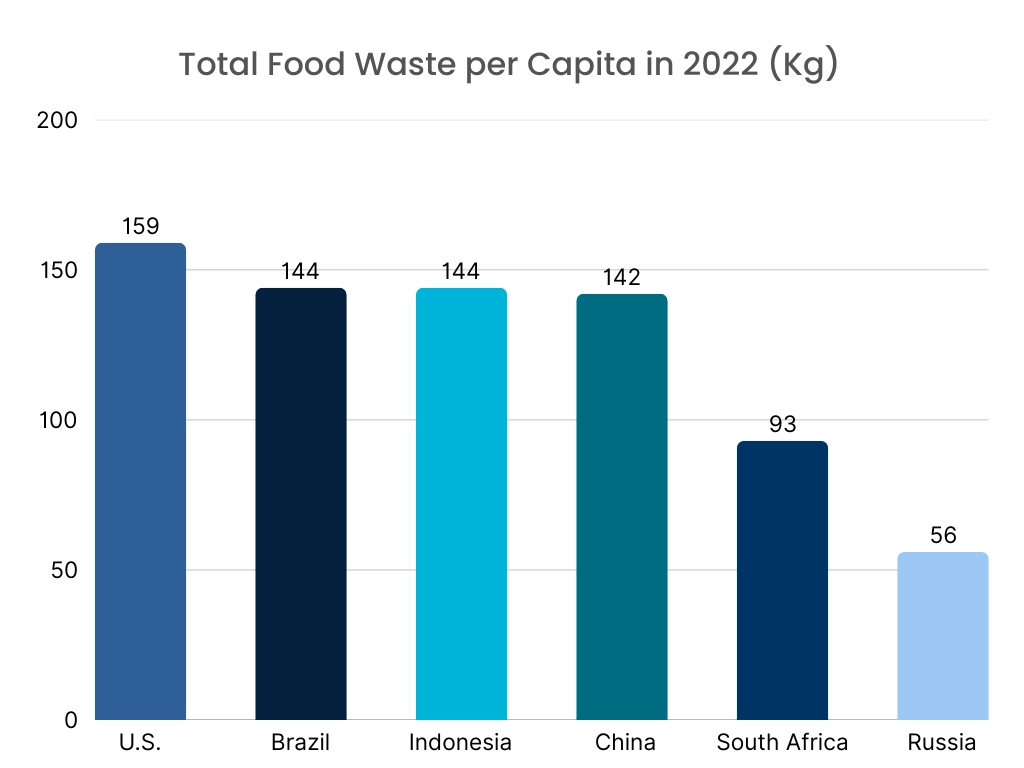
Top Key Players & Market Share Insights:
The global wet waste management market is highly competitive with major players providing solutions to the national and international markets. Key players are adopting several strategies in research and development (R&D), product innovation, and end-user launches to hold a strong position in the market. Key players in the wet waste management industry include-
- Advanced Disposal Services, Inc. (U.S.)
- Clean Harbors Inc. (U.S.)
- Suez SA (France)
- Biffa (U.K.)
- GFL Environmental (Canada)
- Progressive Waste Solutions Ltd (U.K.)
- Remondis Se & Co. KG (Germany)
- Veolia (France)
- Stericycle (U.S.)
- EcoWaste Solutions (U.S.)
Recent Industry Developments :
Project Launch:
- In November 2024, the Indian government initiated the National Mission for Natural Farming (NMNF), to eliminate reliance on chemical fertilizers by supporting around 1 crore (10 million) farmers. The scheme focuses on encouraging cow dung-based fertilizer and other locally available non-chemical fertilizers. By combining segregated wet waste with NMNF, it will provide a service by enhancing waste management under Swachh Bharat Mission (SBM).
Wet Waste Management Market Report Insights:
| Report Attributes | Report Details |
| Study Timeline | 2019-2032 |
| Market Size in 2032 | USD 184.81 Billion |
| CAGR (2025-2032) | 4.6% |
| By Waste Type |
|
| By Service |
|
| By Source |
|
| By End User |
|
| By Region |
|
| Key Players |
|
| North America | U.S. Canada Mexico |
| Europe | U.K. Germany France Spain Italy Russia Benelux Rest of Europe |
| APAC | China South Korea Japan India Australia ASEAN Rest of Asia-Pacific |
| Middle East and Africa | GCC Turkey South Africa Rest of MEA |
| LATAM | Brazil Argentina Chile Rest of LATAM |
| Report Coverage |
|
Key Questions Answered in the Report
How big is the Wet Waste Management Market? +
Wet waste management market size is estimated to reach over USD 184.81 Billion by 2032 from a value of USD 124.56 Billion in 2024 and is projected to grow by USD 128.69 Billion in 2025, growing at a CAGR of 4.6% from 2025 to 2032.
Which is the fastest-growing region in the Wet Waste Management Market? +
Asia-Pacific is the region experiencing the most rapid growth in the market.
What specific segmentation details are covered in the Wet Waste Management report? +
The wet waste management report includes specific segmentation details for waste type, service, source, end user, and region.
Who are the major players in the Wet Waste Management Market? +
The key participants in the market are Advanced Disposal Services, Inc. (U.S.), Clean Harbors inc. (U.S.), Progressive Waste Solutions Ltd (U.K.), Remondis Se & Co. KG (Germany), Veolia (France), Stericycle (U.S.), EcoWaste Solutions (U.S.), Suez SA (France), Biffa (U.K.), GFL Environmental (Canada), and others.
